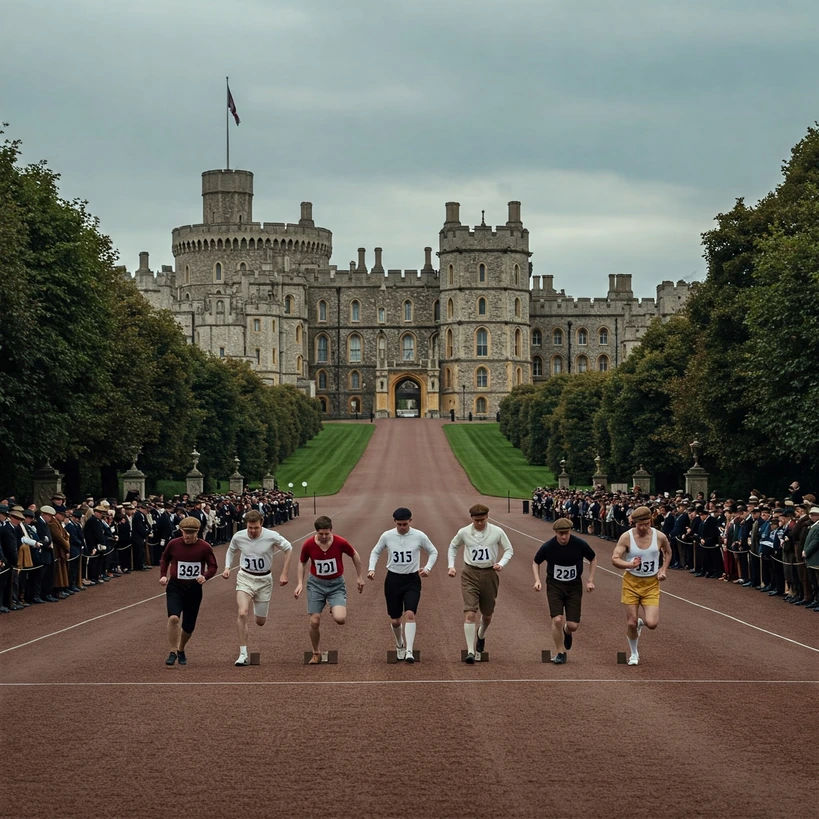Introduction: The Marathon’s Mystique and Its Unique Distance
The marathon holds a unique place in the world of athletics. It’s more than just a race; it’s a symbol of extreme human endurance, instantly recognizable by its specific and somewhat peculiar distance: 26.2 miles. This iconic challenge captivates people globally, drawing elite athletes and everyday runners to city streets worldwide. But have you ever stopped to wonder why it’s precisely 26.2 miles? Why not a round 25 or 30? The length, officially 26 miles and 385 yards (or 42.195 kilometers), seems strangely arbitrary. The answer isn’t rooted in ancient mandates or scientific precision. Instead, the modern marathon distance is a product of historical chance, blending ancient Greek legend, the early days of the modern Olympics, and, crucially, the specific planning and royal preferences surrounding the 1908 London Olympics. This historically determined distance was later cemented by international athletics organizations. Let’s trace this fascinating journey from the battle plains of ancient Greece to a London stadium and the eventual standardization of the distance we run today.
The Legend of Pheidippides: Ancient Inspiration
Our story starts long before the first organized marathon race, on the plains of Marathon, Greece, around 25 miles northeast of Athens. In 490 BCE, a small Athenian army won a surprising victory against the invading Persian forces, a key moment that helped safeguard Athenian democracy. This battle provides the historical backdrop for the legend that inspired the race.
The earliest reliable account of long-distance running related to the battle comes from the historian Herodotus. He wrote about an Athenian messenger, a professional day-runner named Pheidippides (or Philippides), who was dispatched before the battle. His mission was to run from Athens to Sparta, a grueling journey of about 150 miles, to request military aid. Herodotus makes no mention of anyone running from Marathon to Athens after the battle to announce the victory. The famous story we often hear – the messenger running from Marathon to Athens, shouting “Nike!” (Victory!), and then collapsing dead from exhaustion – actually appeared much later, in writings by Plutarch and Lucian centuries after the event. Historians largely view this later version as a romantic invention or a conflation of different historical events, perhaps blending Pheidippides’ documented run to Sparta with the Athenian army’s rapid march back to Athens after the battle.
Despite its questionable historical accuracy, the dramatic tale of the victory run captured imaginations, especially during the 19th-century revival of interest in classical history. Poems like Robert Browning’s “Pheidippides” helped popularize the legend. It was this powerful story, embodying endurance and sacrifice, that directly inspired French historian Michel Bréal to propose a long-distance race commemorating the feat for the first modern Olympic Games in Athens in 1896. Thus, the modern marathon was born not from historical fact, but from the appeal of a compelling narrative.

The First Modern Marathons: Early Olympic Distances
The first official Olympic marathon took place on April 10, 1896, in Athens. The course started near Marathon Bridge and finished in the Panathenaic Stadium in Athens, covering a distance of approximately 40 kilometers, or about 24.85 miles. This distance was chosen partly for its symbolic connection to the legend and partly because similar distances (around 40 km or 25 miles) were already being used in emerging long-distance road races in places like France and the United States. The race was a huge success, won by Greek water-carrier Spyridon Louis, instantly making the marathon an iconic Olympic event.
However, this ~40 km distance wasn’t immediately standardized. The marathon lengths in the next few Olympics varied, often depending on the specific route chosen by the local organizers. The 1900 Paris Olympics marathon was 40.26 km (25.02 miles), while the 1904 St. Louis race returned to about 40 km (24.85 miles). The unofficial 1906 Intercalated Games in Athens featured a marathon of 41.86 km (26.01 miles). Despite these fluctuations, the distance generally stayed close to the 40 km / 25-mile mark during this early period. The focus was more on the spirit of the event inspired by Pheidippides and the logistical challenge, rather than on achieving a precise, standardized length.
London 1908: The Distance is Defined
The turning point came at the 1908 London Olympics. Initial plans suggested a distance similar to previous games, around 25 miles or 40 kilometers. The organizers planned a route starting at the historic Windsor Castle and finishing inside the newly built White City Stadium.
A key factor influencing the final distance involved the British Royal Family. The popular story is that Queen Alexandra requested the starting line be placed on the East Lawn of Windsor Castle, beneath the royal nursery windows, so the children could watch. While this picturesque reason is often cited, official documents also suggest logistical concerns, like avoiding crowds at the start, played a role in choosing this private starting location within the castle grounds. Regardless of the exact motive, starting on the East Lawn, rather than outside the castle gates, added about 700 yards to the course compared to initial considerations. This decision, influenced by royal presence or practical planning, pushed the distance beyond the originally anticipated 25-26 miles.
Another crucial adjustment happened at the finish line. Organizers decided the race should end directly in front of the Royal Box inside White City Stadium. However, shortly before the Games, they realized the planned entrance for the runners wasn’t suitable; it was elevated and didn’t lead directly to the track. A new entrance had to be quickly arranged, diagonally opposite the Royal Box. This last-minute change meant the runners had to cover a specific distance on the stadium track to reach the finish line. That track segment measured exactly 385 yards.
The combination of the road distance from the specific Windsor Castle start point (about 26 miles) and the final 385 yards on the stadium track resulted in the unique total distance: 26 miles and 385 yards (42.195 kilometers). The race itself was incredibly dramatic, famously featuring the collapse of Italian runner Dorando Pietri near the finish, who was helped across the line and later disqualified, awarding the victory to American Johnny Hayes. While this drama cemented the 1908 race in memory, it was the specific logistical decisions – the royal start and the adjusted stadium finish – that accidentally created the distance we know today.
Making it Official: Standardization by the IAAF
Even after the memorable 1908 London race, the distance of 26 miles 385 yards wasn’t immediately adopted everywhere. The 1912 Stockholm Olympics marathon was 40.2 km (24.98 miles), and the 1920 Antwerp marathon was officially 42.75 km (26.56 miles), although its actual length is debated. This inconsistency highlighted the need for a single, official distance.
The International Amateur Athletic Federation (IAAF), founded in 1912 (now known as World Athletics), was created precisely to standardize rules and records in international athletics. Establishing a fixed marathon distance was crucial for fair comparison between races and for ratifying world records. In 1921, the IAAF made its decision: it officially adopted the distance used in the 1908 London Olympics – 42.195 kilometers (equivalent to 26 miles 385 yards) – as the standard marathon length. This distance was first used in the 1924 Paris Olympics and has been the standard ever since for all official competitions. The choice wasn’t based on the distance having any special merit, but because the well-documented 1908 London race provided a convenient and prominent precedent for the IAAF to use in establishing much-needed uniformity.

Decoding the Distance: 42.195 km vs. 26.2 Miles
So, the official marathon distance, mandated by World Athletics for all sanctioned races and records, is exactly 42.195 kilometers. This metric length corresponds precisely to the imperial distance set in 1908: 26 miles and 385 yards.
Where does “26.2 miles” come from? It’s simply a convenient rounding of the actual mile equivalent. Converting 42.195 kilometers to miles gives approximately 26.219 miles. For simplicity in popular discussion, media reports, and training logs, this is often rounded to 26.2 miles. However, race organizers and officials always use the exact 42.195 km / 26 miles 385 yards standard for course measurement and record validation.
Conclusion: A Distance Shaped by History and Happenstance
The journey to the modern marathon distance of 26.2 miles (or 42.195 km / 26 miles 385 yards) is a fascinating story of how history unfolds. It starts with an inspiring, albeit likely embellished, ancient Greek legend. The first modern races used an approximate distance based on that legend. The pivotal moment was the 1908 London Olympics, where a unique mix of a royal starting point and a necessary adjustment to the stadium finish line resulted in the specific length of 26 miles and 385 yards. This distance, born from circumstance rather than design, was later officially adopted by the IAAF in 1921 to standardize the sport.
Therefore, the iconic 26.2-mile marathon distance isn’t based on ancient measurements or scientific reasoning. It’s a historical accident, a legacy of the 1908 London Games, solidified by the need for international uniformity. This peculiar origin story, blending myth, monarchy, and modernization, only adds to the enduring mystique of one of the world’s greatest tests of endurance. Kaynaklar ve ilgili içerik
For further reading and to explore the details behind the marathon’s history, please review the sources consulted for this post listed below.
- History of the Marathon | AIMS | Running into history (Accessed: April 13, 2025)
- Marathon – Wikipedia (Accessed: April 13, 2025)
- Marathon History: Why the Royal Family wanted a 26.2 mile race (Accessed: April 13, 2025)
- Why Is A Marathon 26.2 Miles? Some Blame The British Royal Family | IFLScience (Accessed: April 13, 2025)
- Pheidippides – Wikipedia (Accessed: April 13, 2025)
- Pheidippides | Greek soldier – Britannica (Accessed: April 13, 2025)
- The Olympic Marathon’s Outlandish Early History (Accessed: April 13, 2025)
- Athletics at the 1908 Summer Olympics – Men’s marathon – Wikipedia (Accessed: April 13, 2025)
- Marathon – World Athletics (Accessed: April 13, 2025)
- Marathon world record progression – Wikipedia (Accessed: April 13, 2025)

About the Author
Lost Pace is an ultramarathon runner, shoe-tester and the founder of umit.net. Based year-round in Türkiye’s rugged Kaçkar Mountains, he has logged 10,000 + km of technical trail running and completed multiple 50 K–100 K ultras.
Blending mountain grit with data, Lost analyses power (CP 300 W), HRV and nutrition to craft evidence-backed training plans. He has co-written 260 + long-form guides on footwear science, recovery and endurance nutrition, and is a regular beta-tester of AI-driven coaching tools.
When he isn’t chasing PRs or testing midsoles, you’ll find him sharing peer-reviewed research in plain English to help runners train smarter, stay healthier and finish stronger.
Ultrarunner · Data geek · Vegan athlete

